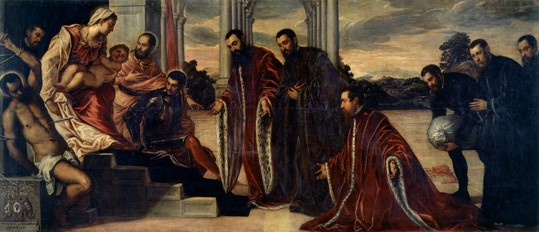Per capire il Tintoretto (Jacopo Robusti) figlio di un manovale che colorava i tessuti, inviso a Tiziano e al Veronese, bisognava venire a Washington DC.
Ed anche questa e' America, Gente!, non solo quella cafona di certa politica.
___________________________________________________________
First Tintoretto Retrospective in America Celebrates Venetian Master's 500th Birthday

Jacopo Tintoretto, The Madonna of the Treasurers, 1567, oil on canvas, overall: 221 × 521 cm (87 × 205 1/8 in.) , Gallerie dell'Accademia, Venice
Washington, DC—Jacopo Tintoretto (c. 1519–1594) was a formidable competitor during his lifetime to the Venetian painters Titian and Veronese, yet he slipped into secondary status in the ensuing centuries. Now, coinciding with the 500th anniversary of his birth, a landmark exhibition on view from March 24 through July 7, 2019, at the National Gallery of Art, Washington, reasserts his place as one of the greatest Italian painters of the 16th century. The first full-scale retrospective of the artist in America, Tintoretto: Artist of Renaissance Venice presents a complete overview of his work, thanks to many significant loans traveling to the U.S. for the first time. The exhibition is currently on view through January 6, 2019, at the Palazzo Ducale in Venice, where it serves as the centerpiece of citywide celebrations in Tintoretto's birthplace.
The Gallery's presentation comprises 46 paintings and ten drawings. The majority of the paintings are immense, stretching nine, ten, or even 16 feet in the case of Paradiso (modello) (c. 1583, Museo Thyssen-Bornemisza). Other highlights of the exhibition are a gallery devoted to portraits, revealing that Tintoretto was one of the great portraitists of his day; a substantial group of works on loan from the Gallerie dell'Accademia and Palazzo Ducale; and a film with breathtaking views of the artist's paintings in their Venetian settings. Among the loans leaving Italy for the first time are four that have undergone major conservation projects recently, sponsored by the American nonprofit, Save Venice. One of those, Saint Martial in Glory with Saint Peter and Saint Paul (1549, Church of San Marziale) will be installed outside the exhibition in the West Building's Lobby B.


